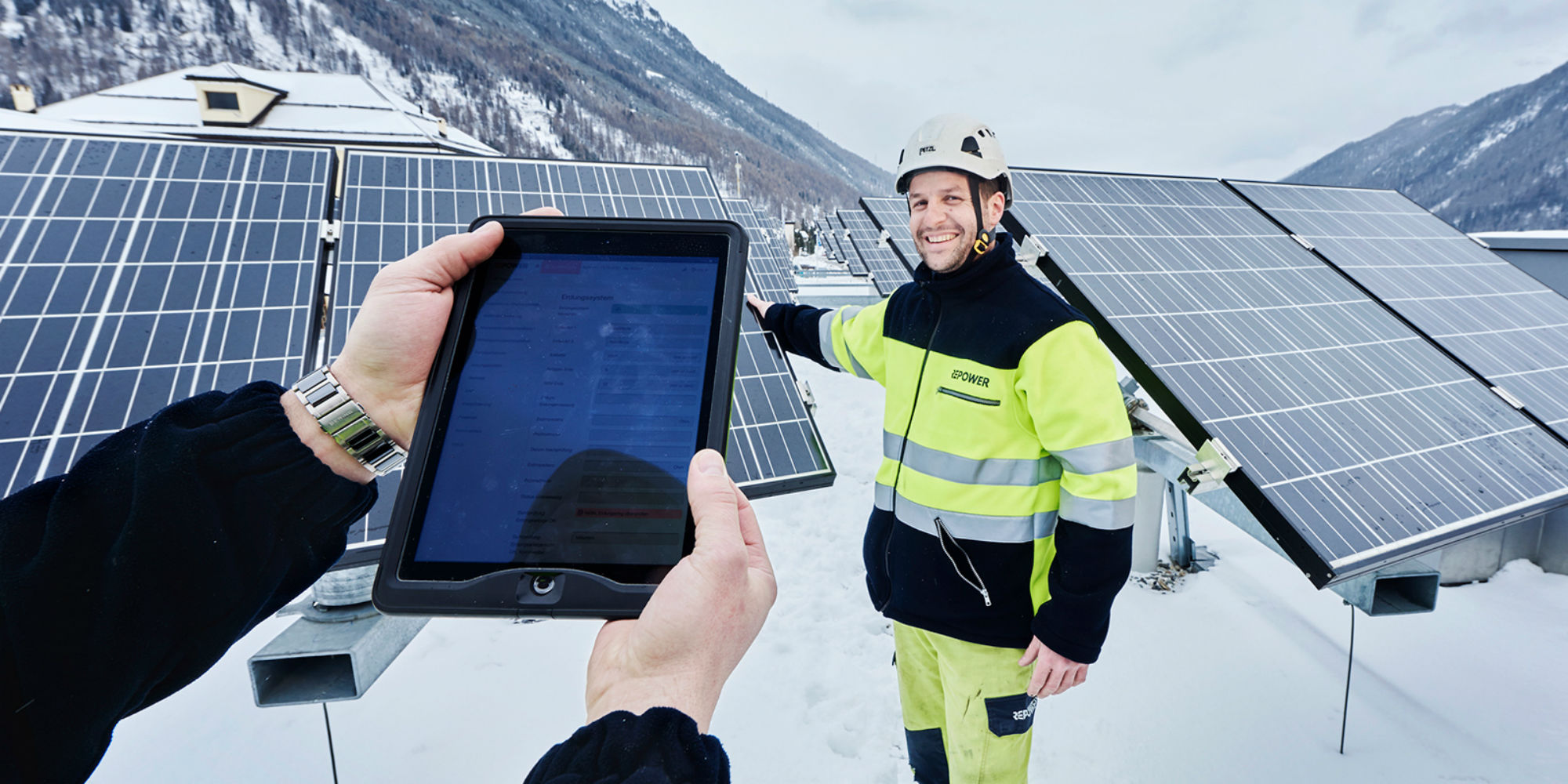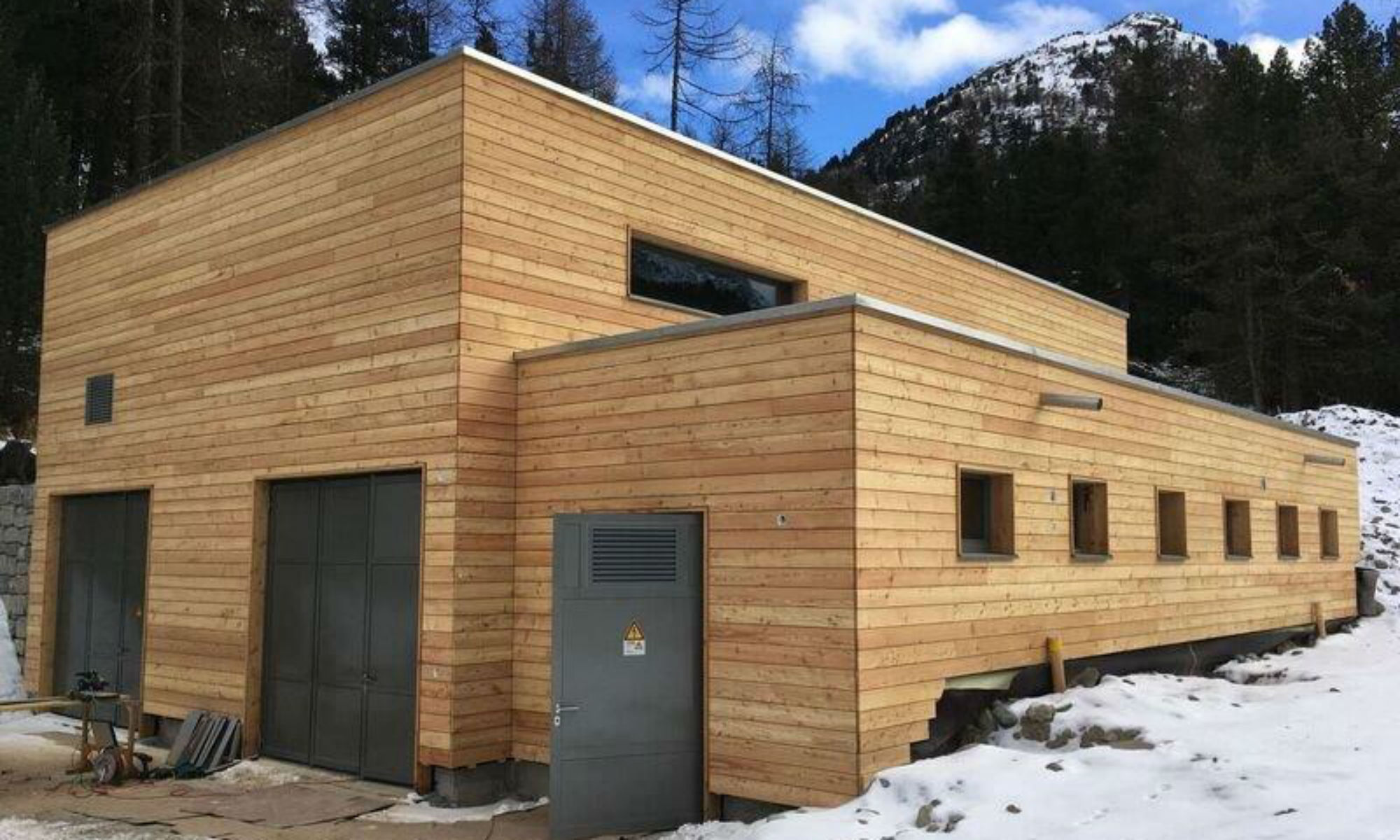
Market Switzerland segment
OVERVIEW
In 2016, Sales at Repower focused on structuring and professionalising the grid, trading and generation service offerings. Repower offers these services to other energy companies as well as to industrial and commercial customers.
Repower also decided that in future it would be supplying its end-consumers with 100 per cent renewable electricity. In line with this policy the product range now encompasses Aquapower (100 per cent Swiss hydropower), the green power mix Purepower, and Solarpower, pure solar energy from the region. Repower delivers these products to around 46,000 end-consumers ranging from private households and commercial customers to downstream municipal utilities.
On both the Swiss and German markets Repower offers municipal electricity companies, large customers and other energy utilities structured energy supply, guarantees of origin and certified power products.
Last year also saw the market launch of the Plug’n Roll electric vehicle service. Together with its customers Repower has already installed more than 60 charging stations, and the Plug’n Roll charging network covers over 1,000 registered drivers of electric vehicles. The company is endeavouring to extend this service across Switzerland.
On the Grid side, in 2016 Repower invested around CHF 11.5 million in its assets. Expenditure on regular maintenance came to CHF 8.3 million. These investments help improve the security of supply and make a substantial contribution to the implementation of the federal government’s Energy Strategy 2050. Repower plans to further extend its pan-regional high-voltage grid in areas including Landquart-Prättigau-Davos.
Grid is also engaged in innovation. In the year under review Repower continued to develop its Smart Home solution. This is designed to give customers incentives to adapt their energy use and help them manage their electricity consumption intelligently and efficiently.
Repower also has an innovative solution called Asset Monitor for infrastructure operators. The tool simplifies maintenance and planning by digitising and bundling all the relevant asset data.
In 2016 Grid also worked on numerous maintenance and service contracts for third parties. Added to this it provided services in connection with public lighting, grid management and regulatory management.
For Trading, 2016 was a year dominated by very volatile forward prices, which made trading operations very challenging. For this reason the focus was on asset optimisation and providing ancillary services. In addition to this, Repower continued to extend its service offering to other energy utilities. This includes services related to market access, market information, balance group management, portfolio management, energy procurement and forecasting.
The approval process for the project to build a merchant line between Val Bregaglia (Bergell) and Italy was driven forward in 2016.
On the Generation side, electricity produced by Repower’s own hydropower plants came to 622 gigawatt hours, an average result by the standards of recent years.
At the end of the year Repower connected the completely refurbished Morteratsch power plant in the Engadine to the grid. The building work was completed in record time, and for the first time Repower joined forces with an infrastructure fund to finance the project. This marked a further step in safeguarding the value of Repower’s hydropower assets – particularly as the Morteratsch plant as well as the Cavaglia installation in the Valposchiavo and Trun in the Surselva now qualify for the feed-in remuneration at cost scheme.
In autumn 2016 Canton Graubünden granted project approval for the Lagobianco pumped storage power plant project. This approval also creates the basis for the renovation and continued operation of the existing power plants in the Valposchiavo. The two hydropower projects, Chlus and Taschinas 2, are still at the concession and project approval phase respectively.
Last year the Repartner production investment company made significant progress: from 2017 the ten energy utilities involved will take around 240 gigawatt hours of electricity per year from four hydropower plants in the Prättigau.
In 2016 Repower’s Market Switzerland segment posted operating income (EBIT) of CHF 13 million.
Sales
In line with its role as a sales-oriented energy company with a great deal of know-how in grids, trading and generation, in 2016 Repower increasingly focused on providing services for other energy companies and industrial and commercial customers. Its offering runs from generation-related services such as operating, maintaining and engineering power plants through grid services such as grid planning and lighting management to trading-related services such as balance group management, market access and portfolio management. While individual units take care of the technical aspects, the role of Sales is to structure and professionalise the service offering and position it in the market. In 2016 Repower took important steps in this direction, and will continue to expand its service business in the future (see also the box on works and services for third parties below).
Repower provides electricity to around 46,000 private and commercial customers in its supply area in Southeast Switzerland. Last year the company decided that in future it would only be offering electricity generated from renewable resources. For this reason from 2017 it will stop offering Mixpower, a product consisting of electricity from indeterminate European sources. The product range now comprises Aquapower, Purepower and Solarpower. The standard product Aquapower is Swiss hydroelectric power; Purepower is a certified green power mix from the Swiss mountains; and Solarpower is certified solar energy from the region. This move underscores Repower’s commitment to sustainability also when supplying electricity to end-consumers.
In 2016 Repower also continued to operate on the market for structured energy supply, certified power products (for example with Verdepower, a newly launched product comprising certified green power from Graubünden) and providing guarantees of origin to large customers. In addition to marketing these offerings in Switzerland, Repower also does business in Germany, particularly with numerous municipal utilities and industrial customers.
In 2016 Repower also staged an advertising campaign to successfully launch the Plug’n Roll service. Plug’n Roll is an intelligent network of electric charging stations designed to make travelling in electric vehicles easier. The service is offered on the one hand to drivers of electric vehicles who, thanks to Plug’n Roll, can find stations where they can charge their car all over Europe. They do this via an app which shows all operators of charging stations, including the relevant information. Plug’n Roll is also geared to so-called hosts: companies, restaurants, hotels and municipalities that operate one or more charging points for use by their guests. To do this hosts pay a monthly subscription including PALINA or BITTA charging stations plus all the relevant services such as maintenance, troubleshooting, billing management and network membership. PALINA and BITTA charging stations can also be bought without a subscription. Last but not least, Repower also offers Plug’n Roll as a so-called white label solution enabling companies to sell the finished product to their customers under their own name. Since launch, more than 60 charging points have already been installed at around 30 different locations in Canton Graubünden and the surrounding area. Added to this, more than 1,000 electric vehicle drivers have already signed up on the Plug’n Roll app. Repower plans to extend the service beyond the canton.

Repower holds a 35 per cent interest in the tiko storage network. In the year under review, the operator of the network, Swisscom Energy Solutions, got new partners on board. Not only did the company make contact with regional energy providers to raise awareness of tiko among their customers, but it managed to forge new partnerships with a major German battery manufacturer and a large French energy provider. tiko connects a large number of electric heating systems to create a storage network that can provide balancing energy for the market. By the end of 2016 more than 6,500 households were part of the tiko network. As a supplement to this customer pool, Repower is also involved in providing balancing energy in the form of hydropower.
Grid
Electricity grids will play a key role in implementing the Swiss federal government’s Energy Strategy 2050. The ability to integrate distributed energy resources such as photovoltaic installations and sustainable power applications such as electric vehicles and batteries into the system will depend on expanding and strengthening electricity grids. Repower contributes to this development through ongoing investment in its grid assets. In 2016 this investment came to CHF 11.5 million. Added to this was regular maintenance to the tune of a good CHF 8 million.
The grid association in northern Graubünden which Repower created in 2015 with Axpo and ewz is also designed to improve efficiency and security of supply. In concrete terms this means that the three companies exploit synergy in grid operation and expansion. This set-up has been operating successfully for two years already. Last year the focus was on optimisation on the operational side.
Repower is planning its next project to strengthen and extend the high-voltage grid, this time in the Landquart, Prättigau and Davos area. The first phase in 2017 will involve enhancing the level 3 high-voltage grid between the Sarelli substation near Landquart, the Landquart substation and the substation at Landquart paper factory. A large part of the existing overhead lines, along with the Rhaetian Railways transmission line that runs parallel, will be run underground. The first stage of the extension will involve investment of around CHF 7.3 million. In the next stages, slated for the years that follow, the grid in the Klosters-Davos area will also have to be expanded. In parallel to this, plans to extend the high-voltage grids in the Upper Engadine and Surselva are already under way.
Last year, on the basis of a Federal Administrative Court ruling, the Federal Electricity Commission (ElCom) set the provisional compulsory purchase value of the transmission grid transferred to Swissgrid ownership in 2013. This would mean Repower would receive around CHF 4.6 million in additional compensation for the transmission grid it handed over. The final regulatory value, however, will only be available following a further adjustment to the valuation. ElCom will make this adjustment once all pending proceedings related to the valuation of the transmission grid have been completed.
Repower launched Switzerland’s first true smart grid tariff back in 2014. Under the innovative solution, called Repower Smart Home, the grid price is determined by the electric power (the rate per unit time at which the energy is delivered) utilised by the customer rather than the absolute volume of electricity used, as is currently usually the case. This creates clear incentives for customers to limit the grid power output they utilise and thus limit the expansion of the grid. Alongside the tariff (Smartpower), the Smart Home package also includes a smart meter and Smart Manager, a device for automatically managing electrical appliances. There is a pilot currently under way with test customers to find out whether the tariff creates the right incentives and how it could be further optimised. The goal is to rapidly turn the solution into a marketable product that can be made available to other grid operators.
Another innovative development from Repower is the Asset Monitor. The tool makes it possible to digitise the process for inspecting and managing maintenance work on infrastructure assets and thus avoid inefficient paperwork with a lot of duplications. The Asset Monitor bundles all the important technical, financial and accounting data related to the asset to enable more efficient maintenance and facilitate strategic multi-year planning. Repower has been using the tool for its own assets since the beginning of 2016. At the end of the year it got its first outside customer, the Rhaetian Railway, on board.

TRADING
Market conditions for trading were challenging last year. Prices on the forward markets were highly volatile. At the beginning of the year prices declined sharply before climbing substantially again between April and November. There was another sharp fall towards the end of the year. This meant that despite a number of opportunities, the market access business was tough. While this business made a positive contribution, it lagged behind expectations.
Under the circumstances the focus was on short-term asset optimisation and ancillary services. The effects of cost-savings at various partner plants and various items of extraordinary income helped reduce the procurement costs of energy from participations and limit the losses. On the other hand, cross-border trading between Switzerland and Italy was a lot less profitable than it had been the previous year.

In 2016 Repower expanded its offering of trading services related to market access, balance group management and portfolio management. These efforts were particularly helped by the development of web applications that allow further improvements in transparency, structure and timing of the information exchange with partners. This enabled Repower to acquire new partners for the years to come. The company currently has trading relationships with more than 60 medium-sized energy providers in Switzerland, and is endeavouring to further build this portfolio.
The approval process for the project to build a merchant line between Val Bregaglia (Bergell) and Italy moved forward in 2016. The Swiss authorities granted the construction and operating licence, and the corresponding procedures are still under way on the Italian side. The project was also included in the Ten Year Network Development Plan (TYNDP) drawn up by the European Network of Transmission System Operators (ENTSO-E) and registered as a Project of Common Interest (PCI). Once the construction and operating licence has also been granted for the Italian section of the line, the procedure for the temporally limited exclusive use of cross-border capacity will be initiated.
GENERATION AND PROJECTS
In 2016 the electricity generated by Repower’s own hydropower plants came to 622 gigawatt hours, an average figure by the standards of the last ten years. Last year Repower invested a total of CHF 4.1 million in its assets (not including the newly constructed Morteratsch power plant). Owing to less favourable wind conditions, the two wind farms in Germany that are part of the Repartner production investment company’s portfolio generated significantly less electricity than in previous years.
A highlight of 2016 was construction of the new Morteratsch hydropower plant near Pontresina, which was connected to the grid at the end of the year after a record-short period of construction. The new plant completely replaces the old installation and doubles expected power generation to 7 gigawatt hours. For this project Repower developed an innovative financing and operating model, entering into partnership with Reichmuth Infrastruktur Schweiz AG to establish Kraftwerk Morteratsch AG. Reichmuth holds a majority interest in the power plant company and via its infrastructure fund has provided the lion’s share of the financing for the installation, which cost around CHF 10.5 million. Repower is responsible for operating and maintaining the plant. The Morteratsch plant receives feed-in remuneration at cost (KEV).

The Cavaglia power plant in Valposchiavo also underwent partial renovation for around CHF 2.9 million and was optimised to be eligible for the KEV scheme. In 2016 the Trun plant in the Surselva also received feed-in remuneration at cost for the first time.
In October the Canton Graubünden administration granted project approval for the Lagobianco pumped storage power plant. This approval also creates the basis for the renovation and adaptation of the existing installations in the Valposchiavo.
The procedure for approval of the concession for the Chlus project in the Prättigau/Rhine Valley area by Canton Graubünden is also under way. At the same time the authorities are looking into upgrading the River Landquart, which has been impacted by the excessive fluctuations in water level from the Küblis power plant, by building the Chlus power plant stage.
The cantonal approval procedure for the Taschinas 2 hydropower project in Vorderprättigau is also under way.
Last year the Repartner Produktions AG production investment company, established by Repower in 2012, underwent a crucial development, as Repower agreed a long-term energy supply agreement with the nine other energy providers involved in Repartner. Under this agreement, from 1 January 2017 energy will be supplied on the basis of the electricity generated by the Klosters, Küblis and Schlappin plants in the Prättigau, a total of around 240 gigawatt hours per year. This move to expand cooperation is very welcome and shows that Repower’s partner strategy is bearing fruit.
EBIT CONTRIBUTION
In 2016 the Market Switzerland segment’s contribution to group operating income (EBIT) came to CHF 13 million. Among other things this includes a negative exceptional item resulting from an increase in the provision for long-term agreements. There was also a negative impact from hedges on fixed supply contracts that had to be done at unfavourable prices under the hedging strategy. An impairment gain on the Taschinas plant led to a positive exceptional item. Another positive factor was the sale of subsidiary connecta ag.
Work and services for third parties
In 2016 Repower geared its organisation to the requirements of a sales and service-based company. The role of Grid, Trading and Generation is to deliver the necessary technical know-how and services for Sales. Work and services for third parties, an integral part of this strategy, were stepped up in 2016.
In 2016 Grid was commissioned by other power providers to do a variety of maintenance and service work on their grids. One example is Engadiner Kraftwerke, where Repower has a contract running several years to maintain and extend assets.
Repower’s offering also includes optimising public lighting systems. The company’s service offering includes advice, planning and calculation, construction and fitting for new assets. In the year under review Repower delivered major projects in the communities of Falera, Schluein, Ilanz and Surrein in the Bündner Oberland, equipping them with intelligent LED lighting. Smart control can significantly boost efficiency. After fitting Repower can also operate and maintain the equipment and conduct the checks and controls required by the law.
Other services involved grid and regulatory management. Smaller distribution grid operators in particular are seeking partnerships to be able to address increasingly stringent requirements in these areas. In 2016 Repower was already able to support a number of customers with the corresponding services.
Repower offers market-oriented trading services for other energy utilities and commercial customers. This includes support with energy procurement as well as portfolio and risk management, where Repower provides customers with market information, specific advice, forecasts and analysis. Repower also provides access to wholesale markets and takes care of balance group and ancillary services management on behalf of its customers.
National grid operator Swissgrid AG has commissioned Repower with the job of planning, tendering for and managing construction of the new 220-kV Avegno substation in Canton Ticino. Construction started in autumn 2016 after completion of the planning work and approval procedure.
In Pradella in the Lower Engadine, Repower commissioned a new 110-kV substation, and completed the second of four stages of the 400-kV substation. In 2017 Repower will supply and fit various technical components for the renovation of the Martina power plant. The work at Pradella and Martina is being done on behalf of Engadiner Kraftwerke (EKW).
Last year Repower completely overhauled the remote control for five of 14 substations on behalf of the Rhaetian Railway. This work will continue in 2017.